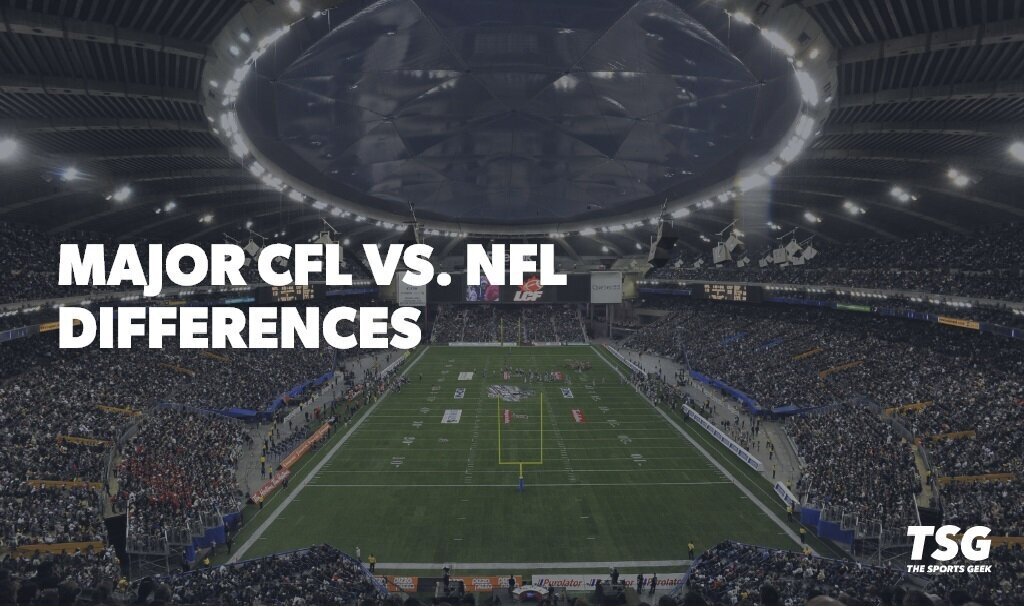
There are so many CFL vs. NFL differences that it almost seems like a different game when you pit the two against one another! Let’s break down the most crucial differences in the CFL vs. NFL battle, from the size of the field to the number of players, and everything in between!
What are the Biggest CFL vs. NFL Differences?
Here are the most important variations between the CFL and NFL games:
- Size of the field
- Number of players on the field
- Number of downs
- Scoring differences
- Minor rule differences
CFL vs. NFL — Size of the Field
The biggest CFL vs. NFL difference, literally, is the size of the field the game is played on. The CFL field of play is 110 yards by 65 yards wide. The NFL field is 100 yards long by 53.3 yards wide. The CFL has a 55-yard line in the middle of the field, while you’ll find the NFL has the 50-yard line.
One thing you’ll notice about the field is the location of the goalposts. In the NFL, they’re at the very back of the end zone. But in the CFL, the goalposts are right at the goal line. Even Canadian NFL players would have to get used to that if they played in the CFL at some point.
The end zones are also a major difference in the CFL vs. NFL. The CFL end zone is 20 yards deep, while the NFL’s end zones are 10 yards deep. An NFL expansion team that had to practice in Canada might not know what to do with all that extra room!
CFL vs. NFL – Number of Players on the Field
If you thought that there should be more players on the CFL field than the NFL since it’s bigger, you would be correct! There are 12 players on the field in the CFL, while there are 11 players in the NFL.
You’ll also notice on offense that players are allowed a running start up to the line of scrimmage before the ball is snapped. In the NFL, only one person can be in motion, and that player can only run along the line of scrimmage.
In the CFL, everyone, except the quarterback, can be in motion, and receivers can get as much of a running start as they want, providing they don’t cross the line of scrimmage before the ball is snapped. That would result in an offside penalty.
But defenses can be caught off-guard by five receivers running at the line of scrimmage, and the result can be some big plays for the offense!
CFL vs. NFL — Number of Downs
Another considerable difference between the CFL and the NFL is the number of downs teams get, meaning the number of attempts they have to get ten yards of progress. The CFL only allows teams three downs to get ten yards, while it’s four downs in the NFL.
While there is a conversation going on about how much teams pass in the NFL, it’s even more pronounced in the CFL since teams have one less down to get their ten yards. There are running backs in the CFL, but teams will generally rush less because you only have two down before you’re forced to punt.
In 2022, there was more scoring and passing in the CFL than the NFL. On the other hand, there was more rushing in the NFL than the CFL. One down makes a huge difference in how teams strategize in both leagues, and if you’re a Canadian fan of NFL teams, this would take some time to get used to!
CFL vs. NFL — Scoring Differences
The most important difference in CFL vs. NFL scoring is that CFL teams can score one point in an unusual for the NFL way known as a “rouge”.
This is when a team attempts a field goal and misses, and the receiving player can’t get out of the end zone. It’s also when the ball goes through the back of the end zone without being touched by the receiving team. The kicking team gets a point, and the receiving team gets the ball on the 40-yard line.
As shown above, it can result in unique endings to a game. In the NFL, you can only score a single point on a point-after-touchdown, which you can also do in the CFL. In both leagues, you can also have a safety for two points, when a team is backed up in their end zone, and are tackled there.
CFL vs. NFL — Minor Rule Differences
There are a couple of minor CFL vs. NFL rule differences that you should also know about.
No Fair Catch in CFL
In the NFL, players can wave their arm to signal a fair catch when a kicked punt is up in the air. There is no fair-catch rule in the CFL. Instead, there is a no-yards rule, where the kicking team can’t be within five yards of the punt returner. If there are players within five yards, the kicking team gets a 15-yard penalty. If the returner picks up the ball off a bounce, and a kicking-team player is within five yards, they’ll receive a five-yard penalty.
Fewer Timeouts in CFL
In the NFL, teams have three timeouts per half to use. In overtime, they’ll receive two more. But in the CFL, teams get just two timeouts per game, but they can’t both be used in the last three minutes of the game. CFL teams get one more timeout if the game goes to overtime.
Overtime Rules
In the CFL, when teams go to overtime, they’ll start on the opposition’s 35-yard line. If the team scores a touchdown, they have to go for a two-point conversion. Whoever leads after each team gets a possession, wins. In the NFL, each team gets a possession. But if the first team scores a touchdown, the game is over.
Play Clock
NFL teams get 40 seconds in between plays, whereas in the CFL, teams get just 20 seconds in between plays.
Line of Scrimmage
The defense has to be a full yard away from the line of scrimmage before the ball is snapped. That gives the offense a buffer zone of a yard before the play even starts. The Philadelphia Eagles’ “tush push” wouldn’t be needed in the CFL! But in the NFL, the defense has to be 11 inches away, or the length of one football.
The Ball is Now the Same Size
Until 2018, the CFL ball was larger than the NFL ball. The CFL ball was 11 to 11.25 inches long from 1986 to 2017, with a long circumference range of 27.75 to 28.25 inches, and a short circumference range of 20.875 to 21.125 inches.
Now, the CFL ball is the same length, but the long circumference range is 28 to 28.5 inches, and the short circumference range is 21 to 21.25 inches. This is in line with the dimensions of the NFL ball. The leather was also changed on the CFL ball, which was done by consulting the league’s quarterbacks.




You must be logged in to comment. Don't have an account? Sign up today.